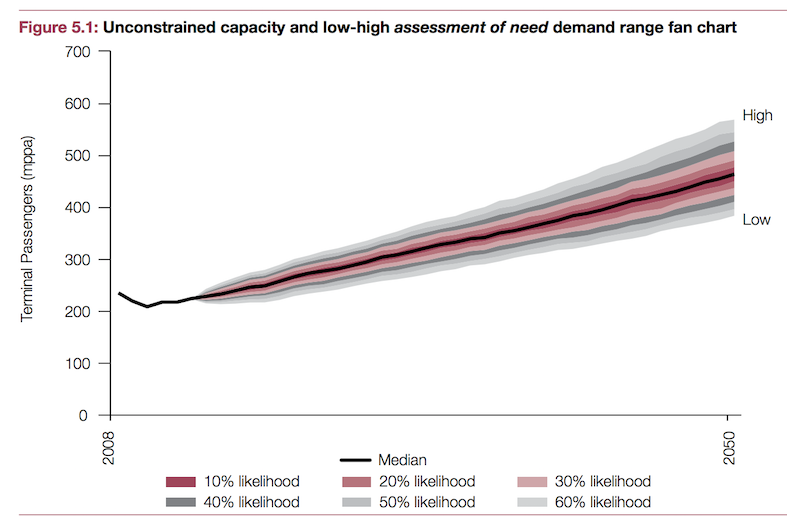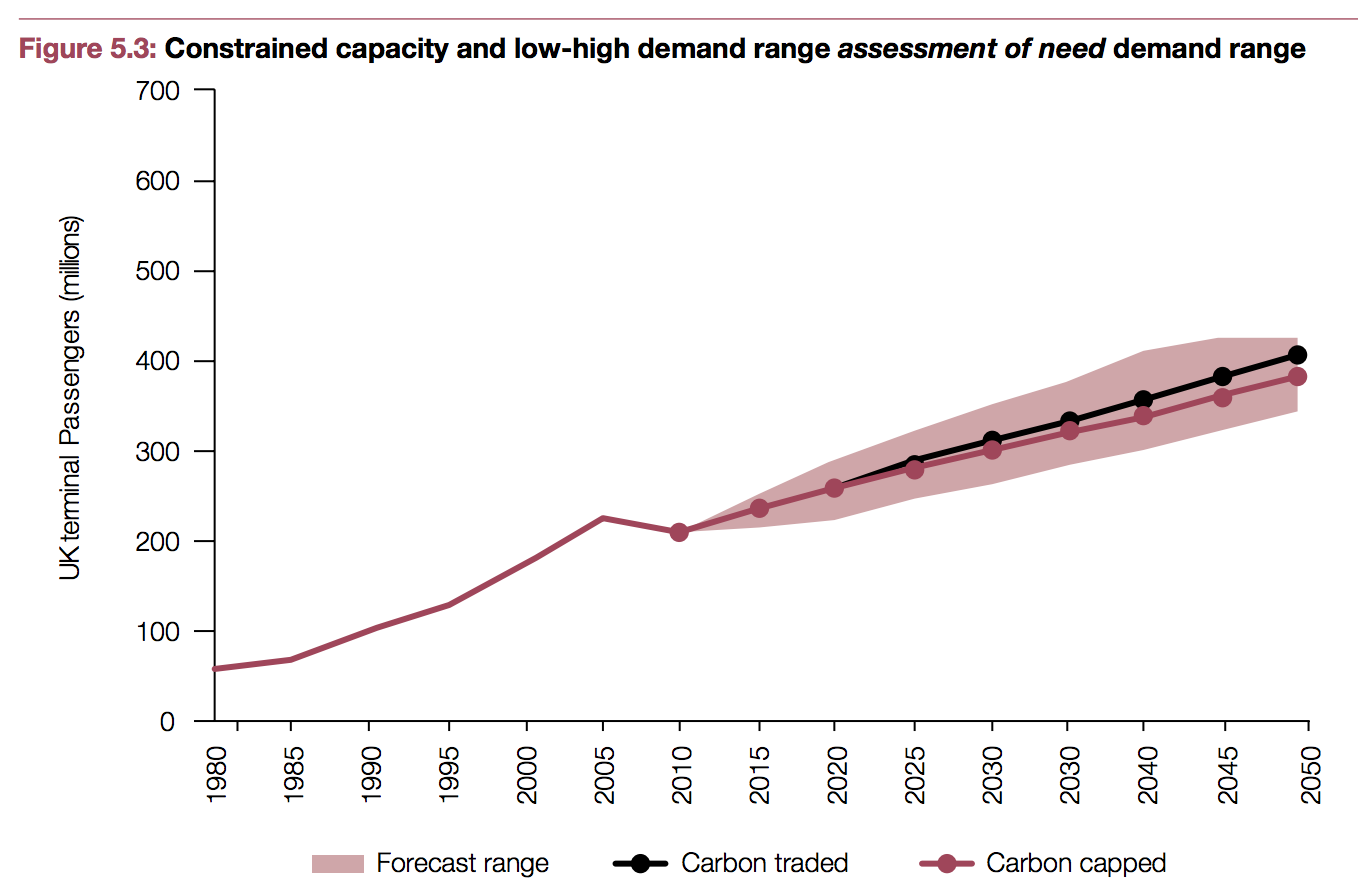New Civil Engineer believes Heathrow, Gatwick and Birmingham set to get go ahead for runways
The NCE believes government will give the go ahead to new runways at both Heathrow and Gatwick – on 18th October. The NCE expects Heathrow would be allowed a runway immediately, and Gatwick could build a 2nd runway within the next 5 years. NCE also understands the government will urge Birmingham airport to plan a 2nd runway. The reason for this decision, other than the difficulties in making it, is ascribed to the forecasts of air passenger numbers being inaccurate. (Forecasts are, of course, usually inaccurate … and air passenger numbers depend on many variables, including oil price, and the strength of the £ and UK and global economy). The DfT produced very bullish passenger forecasts in 2007, which were way too high and knocked back by the recession. Lower forecasts were produced in 2011, and then lower again in 2013. The Airports Commission did its own forecasts, over a range of scenarios – and took account of the fact that aviation expansion would be constrained by the annual cap on CO2 emissions of 37.5 MtCO2. Because air passenger numbers have recovered to their pre-recession levels, it is believed by some that this rapid growth will continue and the forecasts are too low. The “predict and provide” scenario would require more runways. This sort of growth in UK aviation challenges our legally binding UK carbon targets under the Climate Change Act 2008. Details of forecasts below.
.
Tweet
Heathrow, Gatwick and Birmingham set to get go ahead
11 OCTOBER, 2016
BY KATHERINE SMALE (New Civil Engineer)
New Civil Engineer understands that the government is poised to give the go ahead to additional runway capacity at Heathrow and Gatwick.
It is believed that the announcement will be made on 18 October, with government giving the green light to a third runway at Heathrow immediately and also allowing Gatwick to expand with a second runway within the next five years.
Gatwick’s 30-year agreement with local authorities not to expand is due to expire in 2019.
It is also understood that government will urge Birmingham airport to advance its proposals for an additional runway.
The decision to encourage all three airports to expand comes after increasing demand in the London area over the last three years has far exceeded predictions used by Sir Howard Davies’ Airport Commission.
Davies’ published his independent report setting out its recommendations for expanding aviation capacity in the UK in 2015. To meet the projected growth, it said that a new runway was required by 2030 and gave a new northwest runway at Heathrow Airport as the preferred option.
This, however, was based on a predicted growth in passenger numbers from a Department for Transport (DfT) report. This 2013 report used passenger figures from 2010 through to 2012 which saw airport usage at a seven-year low in 2010 after the financial crash in 2008. A slow recovery in 2011 and 2012 may have influenced a low passenger estimate in 2030.
In the report, Heathrow was predicted to rise from 70M passengers per annum (ppa) in 2011 to 85Mppa by 2030. Similarly at Gatwick it predicted a rise in numbers from 34Mppa in 2011 to 42Mppa by 2030. Overall London was predicted to rise from 135M to 184M passengers across Heathrow, Gatwick, Stansted, Luton and London City airport.
However, since 2013, actual passenger numbers have increased at a rate far above this.
In 2015 the total number of passengers at Heathrow was 75M; however, without expansion it is operating at near capacity and will therefore not see a rise in passenger numbers. At Gatwick, the actual number of passengers was 41M and at growth predictions based on data from 2013 to 2015, it is predicted to surpass the 2030 estimate in 2016.
Overall, it has been predicted that if the current growth continues, London would hit the 2030 passenger number of 184M in 2019, 11 years ahead of the forecast.
Birmingham airport was the only non-London based airport to not be entirely discounted by the Airport Commission’s report. The interim report stated that: “It would offer the largest catchment of people within two hours of the airport of all options. This is largely dependent on the journey time assumptions of HS2, which also makes the London airport system easier to access for passengers from Birmingham’s core aviation market.”
However, speaking at New Civil Engineer’s Airports conference earlier this year, UK Civil Aviation Authority (CAA) chief executive Andrew Haines said that even if either Heathrow or Gatwick was given permission to expand, they could face challenges securing the required investors.
He said that because the project did not have government assurance, it would not be bailed out should costs rise, and investors may find it difficult to take on the risk.
“There is no track record of regulation being applied to something of this size,” he said.
Haines explained that it was genuinely unprecedented for there to be a major multi-billion pound infrastructure investment of this scale with absolutely no government guarantee or assistance. He said that the nearest project in terms of scale of investment is Hinkley Point C nuclear power station, and even that comes with government guarantee.
.
See earlier:
.
The Executive Summary, from the January 2013 DfT forecasts, states:
Key findings
This report sets out forecasts of passenger numbers, air transport movements and aviation carbon emissions at UK airports.
Demand for air travel is forecast to increase within the range of 1% – 3% a year up to 2050, compared to historical growth rates of 5% a year over the last 40 years. The slowdown in growth rates in the future reflects the anticipation of market maturity across different passenger markets and a projected end to the long-term decline in average fares seen in the last two decades.
The central forecast, taking into account the impact of capacity constraints, is for passenger numbers at UK airports to increase from 219 million passengers in 2011 to 315 million in 2030 and 445 million by 2050. This is an increase of 225 million passengers over the next 40 years compared to an increase of 185 million since 1970.
The central forecasts of passenger numbers have been reduced by around 7% in 2030 from levels last forecast by the DfT in August 2011. Primarily this reflects revisions to the Office of Budget Responsibility’s (OBR) forecasts for the UK economy and the Department of Energy and Climate Change’s (DECC) projections of oil prices.
The major South East airports are forecast to be full by 2030. However, there is a range around this projection and they could be full as soon as 2025 or as late as 2040. Heathrow remains full across all the demand cases considered.
CO2 emissions from flights departing the UK are forecast to increase from 33.3 MtCO 2 in 2011 to 47 MtCO2 within the range 35 – 52MtCO2 by 2050.
.
These are the constrained forecasts (constrained means no new runways built) from the DfT 2013 forecasts:
These are the unconstrained forecasts (unconstrained means adding runways) from the DfT 2013 forecasts

.
The Airports Commission did their own passenger forecasts in November 2014
https://www.gov.uk/government/uploads/system/uploads/attachment_data/file/374660/AC05-forecasts.pdf
P 55 Unconstrained demand (ie with more runways)

and P 57 Constrained demand (no new runways)

https://www.gov.uk/government/uploads/system/uploads/attachment_data/file/374660/AC05-forecasts.pdf

